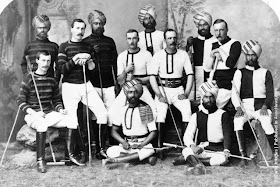The rampant lions, grinning and growling, most in
states if sexual arousal, decorating the outside walls of temples, such as those
at the Kanchi
Kailasanathar (the oldest structure in Kanchipuram) or being used as
ornate pillars, to support structures, are appealing as well as sending a
strong message to those who could read the signs.
 |
| Pallava lion at temple in Kanchipuram |
 |
| Pallava coinage from c 650 AD the lion and the bull were the symbols of the dynasty |
 |
| Ramesses II statue at Abu Simnel |
 |
| Pallava lion at Mamallapuram Carved out of a single rock As were elephant and temples behind it |
 |
| British Army Polo Team, Hyderabad mid 19th century Army officers and Indian princes |
 |
| Water being delivered on the streets of modern Chennai |
 |
| Madras High Court and Law College 1899 |
Another explanation is that the Portuguese, who were the first to arrive in the area in 1522, referred to the settlement they established as Madre de Deus. They had built a church, called Madre de Deus, near the natural harbour where they first landed. The preeminent Roman Catholic church in the formerly Portuguese area of Madras has changed significantly since then. It is now Santhome Church, the site of international pilgrimage as "Doubting Thomas", one of only 3 of Christ's named Apostles with a known location for his death and burial, has his shrine in the Basilica beneath the main church. According to tradition, Thomas was killed in 72 AD by Hindus who disliked his conversion of their fellows, although Marco Polo claimed that he was shot by a fowler, with a poor aim, who had been shooting peacocks.
 |
| Santhome Church exterior, Chennai |
Very jealous !! Great insights
ReplyDelete